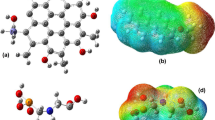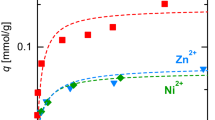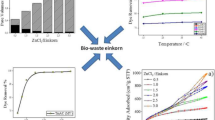Abstract
This study describes the synthesis of activated carbon from locally derived biomass Rubus alceifolius using ZnCl2 as an activating agent for sulfadiazine (SDZ) removal from wastewater. The adsorbent material was characterized by Fourier transform infrared (FTIR), powder X-ray diffraction (XRD), X-ray photoelectron spectroscopy (XPS), scanning electron microscope (SEM), N2 adsorption–desorption isotherms, and zero-point charge (pHzpc). Brunauer–Emmett–Teller (BET) surface area and total pore volume of the synthesized carbon were found to be 233 m2 g−1 and 0.16 cm3 g−1, respectively. Batch adsorption studies were carried out under varying initial concentrations, adsorbent dosage, temperature, contact time, and pH to comprehend the effects of different operating parameters on the removal efficiency for sulfadiazine from wastewater. The equilibrium isotherm study fitted well with the Langmuir model with maximum adsorption capacity (qm) of 29.57 mg g−1. The adsorption kinetic was best fitted by the pseudo-second-order model. Thermodynamic process of adsorption of SDZ onto activated carbon was found to be spontaneous and endothermic. Theoretical investigations using density functional theory (DFT) calculations suggested that the adsorption of SDZ onto functionalized activated carbon is favorable. Among the oxygen-containing functional groups, the carboxyl group appeared to have the largest effect on the adsorption process. However, DFT calculation showed that the presence of all three oxygen-containing functional groups enhanced the adsorption of SDZ, compared with pristine activated carbon.















Similar content being viewed by others
Data availability
The data can be accessed on request from the authors.
Abbreviations
- RAAC:
-
Rubus alceifolius activated carbon
- SDZ:
-
Sulfadiazine
- DFT:
-
Density functional theory
- pHpzc :
-
Zero-point charge
- AC:
-
Activated carbon
- AC_P:
-
Pristine AC
- AC_COOH:
-
COOH functionalized AC
- AC_OH:
-
–OH functionalized AC
- AC_CHO:
-
–CHO functionalized AC
- OH + CHO + COOH_AC:
-
–OH, –COOH, –CHO functionalized AC
References
Aslan S, Şirazi M (2020) Adsorption of sulfonamide antibiotic onto activated carbon prepared from an agro-industrial by-product as low-cost adsorbent: equilibrium, thermodynamic, and kinetic studies. Water, Air, Soil Pollut 231:222. https://doi.org/10.1007/s11270-020-04576-0
Yang JF, Ying GG, Zhao JL, et al (2010) Simultaneous determination of four classes of antibiotics in sediments of the Pearl Rivers using RRLC-MS/MS. Sci Total Environ 408. https://doi.org/10.1016/j.scitotenv.2010.03.049
Wang B, Xu X, Tang H, et al (2020) Highly efficient adsorption of three antibiotics from aqueous solutions using glucose-based mesoporous carbon. Appl Surf Sci 528. https://doi.org/10.1016/j.apsusc.2020.147048
Zhang S, Song HL, Cao X, et al (2019) Inhibition of methanogens decreased sulfadiazine removal and increased antibiotic resistance gene development in microbial fuel cells. Bioresour Technol 281. https://doi.org/10.1016/j.biortech.2019.02.089
Yang W, Hong P, Yang D et al (2021) Enhanced Fenton-like degradation of sulfadiazine by single atom iron materials fixed on nitrogen-doped porous carbon. J Colloid Interface Sci 597:56–65. https://doi.org/10.1016/j.jcis.2021.03.168
Guinea E, Brillas E, Centellas F, et al (2009) Oxidation of enrofloxacin with conductive-diamond electrochemical oxidation, ozonation and Fenton oxidation. A comparison. Water Res 43. https://doi.org/10.1016/j.watres.2009.02.025
Tran NH, Chen H, Reinhard M, et al (2016) Occurrence and removal of multiple classes of antibiotics and antimicrobial agents in biological wastewater treatment processes. Water Res 104. https://doi.org/10.1016/j.watres.2016.08.040
Supong A, Bhomick PC, Baruah M, et al (2019) Adsorptive removal of bisphenol A by biomass activated carbon and insights into the adsorption mechanism through density functional theory calculations. Sustain Chem Pharm 13. https://doi.org/10.1016/j.scp.2019.100159
Djilani C, Zaghdoudi R, Djazi F et al (2015) Adsorption of dyes on activated carbon prepared from apricot stones and commercial activated carbon. J Taiwan Inst Chem Eng 53:112–121. https://doi.org/10.1016/j.jtice.2015.02.025
Martins AC, Pezoti O, Cazetta AL, et al (2015) Removal of tetracycline by NaOH-activated carbon produced from macadamia nut shells: kinetic and equilibrium studies. Chem Eng J 260. https://doi.org/10.1016/j.cej.2014.09.017
Laksaci H, Khelifi A, Trari M, Addoun A (2017) Synthesis and characterization of microporous activated carbon from coffee grounds using potassium hydroxides. J Clean Prod 147. https://doi.org/10.1016/j.jclepro.2017.01.102
Fierro V, Muñiz G, Basta AH et al (2010) Rice straw as precursor of activated carbons: activation with ortho-phosphoric acid. J Hazard Mater 181:27–34. https://doi.org/10.1016/j.jhazmat.2010.04.062
Gupta H, Kumar R (2016) Removal of PAH anthracene from aqueous media using banana peel activated carbon. Int J Sci Res Environ Sci 4. https://doi.org/10.12983/ijsres-2016-p0109-0114
Ezung SL, Baruah M, Supong A et al (2022) Experimental and theoretical insight into the adsorption of 2,4-dichlorophenol on low-cost bamboo sheath activated carbon. Sustain Chem Pharm 26:100643. https://doi.org/10.1016/j.scp.2022.100643
Pezoti Junior O, Cazetta AL, Gomes RC et al (2014) Synthesis of ZnCl2-activated carbon from macadamia nut endocarp (Macadamia integrifolia) by microwave-assisted pyrolysis: optimization using RSM and methylene blue adsorption. J Anal Appl Pyrolysis 105:166–176. https://doi.org/10.1016/j.jaap.2013.10.015
Sharma S, Ezung SL, Supong A et al (2023) Activated carbon adsorbent derived from waste biomass, “Croton caudatus” for efficient removal of 2-chlorophenol from aqueous solution: kinetics, isotherm, thermodynamics and DFT simulation. Chem Eng Res Des 190:777–792. https://doi.org/10.1016/j.cherd.2023.01.002
Daware GB, Gogate PR (2020) Adsorption of 3-aminopyridine (3AP) from aqueous solution using sugarcane bagasse activated carbon (SBAC). Environ Technol Innov 19. https://doi.org/10.1016/j.eti.2020.100921
Farmanzadeh D, Valipour A (2018) Adsorption of benzene and toluene molecules on surface of pure and doped cadmium oxide nanosheets: a computational investigation. Appl Surf Sci 450. https://doi.org/10.1016/j.apsusc.2018.04.195
Zhu X, Zhang L, Zhang M, Ma C (2019) Effect of N-doping on NO2 adsorption and reduction over activated carbon: an experimental and computational study. Fuel 258. https://doi.org/10.1016/j.fuel.2019.116109
Qu Z, Sun F, Liu X, et al (2018) The effect of nitrogen-containing functional groups on SO2 adsorption on carbon surface: enhanced physical adsorption interactions. Surf Sci 677. https://doi.org/10.1016/j.susc.2018.05.019
Serna-Carrizales JC, Collins-Martínez VH, Flórez E et al (2021) Adsorption of sulfamethoxazole, sulfadiazine and sulfametazine in single and ternary systems on activated carbon. Experimental and DFT computations. J Mol Liq 324:114740. https://doi.org/10.1016/j.molliq.2020.114740
Bhomick PC, Supong A, Baruah M et al (2018) Pine cone biomass as an efficient precursor for the synthesis of activated biocarbon for adsorption of anionic dye from aqueous solution: isotherm, kinetic, thermodynamic and regeneration studies. Sustain Chem Pharm 10:41–49. https://doi.org/10.1016/j.scp.2018.09.001
Ramirez A, Ocampo R, Giraldo S et al (2020) Removal of Cr (VI) from an aqueous solution using an activated carbon obtained from teakwood sawdust: kinetics, equilibrium, and density functional theory calculations. J Environ Chem Eng 8:103702. https://doi.org/10.1016/j.jece.2020.103702
Supong A, Bhomick PC, Karmaker R, et al (2020) Experimental and theoretical insight into the adsorption of phenol and 2,4-dinitrophenol onto Tithonia diversifolia activated carbon. Appl Surf Sci 529. https://doi.org/10.1016/j.apsusc.2020.147046
Streit AFM, Collazzo GC, Druzian SP, et al (2021) Adsorption of ibuprofen, ketoprofen, and paracetamol onto activated carbon prepared from effluent treatment plant sludge of the beverage industry. Chemosphere 262. https://doi.org/10.1016/j.chemosphere.2020.128322
Subramanian N, Viswanathan B (2015) Nitrogen- and oxygen-containing activated carbons from sucrose for electrochemical supercapacitor applications. RSC Adv 5. https://doi.org/10.1039/c5ra06661a
Abo El Naga AO, El Saied M, Shaban SA, El Kady FY (2019) Fast removal of diclofenac sodium from aqueous solution using sugar cane bagasse-derived activated carbon. J Mol Liq 285:9–19. https://doi.org/10.1016/j.molliq.2019.04.062
Mondal S, Majumder SK (2019) Honeycomb-like porous activated carbon for efficient copper (II) adsorption synthesized from natural source: kinetic study and equilibrium isotherm analysis. J Environ Chem Eng 7:103236. https://doi.org/10.1016/j.jece.2019.103236
Seo SD, Choi C, Kim BK, Kim DW (2017) Fabrication of highly porous carbon as sulfur hosts using waste green tea bag powder for lithium–sulfur batteries. Ceram Int 43. https://doi.org/10.1016/j.ceramint.2016.10.158
Nayak A, Bhushan B, Rodriguez-Turienzo L (2018) Recovery of polyphenols onto porous carbons developed from exhausted grape pomace: a sustainable approach for the treatment of wine wastewaters. Water Res 145. https://doi.org/10.1016/j.watres.2018.09.017
Suhdi, Wang SC (2021) Fine activated carbon from rubber fruit shell prepared by using ZnCl2 and KOH activation. Appl Sci 11. https://doi.org/10.3390/app11093994
Nasrullah A, Saad B, Bhat AH, et al (2019) Mangosteen peel waste as a sustainable precursor for high surface area mesoporous activated carbon: characterization and application for methylene blue removal. J Clean Prod 211. https://doi.org/10.1016/j.jclepro.2018.11.094
Zeng F, Liao X, Pan D, Shi H (2020) Adsorption of dissolved organic matter from landfill leachate using activated carbon prepared from sewage sludge and cabbage by ZnCl2. Environ Sci Pollut Res 27. https://doi.org/10.1007/s11356-019-07233-0
Liu QS, Zheng T, Li N, et al (2010) Modification of bamboo-based activated carbon using microwave radiation and its effects on the adsorption of methylene blue. Appl Surf Sci 256. https://doi.org/10.1016/j.apsusc.2009.12.025
Inal IIG, Holmes SM, Banford A, Aktas Z (2015) The performance of supercapacitor electrodes developed from chemically activated carbon produced from waste tea. Appl Surf Sci 357. https://doi.org/10.1016/j.apsusc.2015.09.067
Shahrokhi-Shahraki R, Benally C, El-Din MG, Park J (2021) High efficiency removal of heavy metals using tire-derived activated carbon vs commercial activated carbon: insights into the adsorption mechanisms. Chemosphere 264. https://doi.org/10.1016/j.chemosphere.2020.128455
Liu J, Wang S, Yang J, et al (2014) ZnCl2 activated electrospun carbon nanofiber for capacitive desalination. Desalination 344. https://doi.org/10.1016/j.desal.2014.04.015
Danish M (2020) Application of date stone activated carbon for the removal of caffeine molecules from water. Mater Today Proc 31:18–22. https://doi.org/10.1016/j.matpr.2020.01.077
Somsesta N, Sricharoenchaikul V, Aht-Ong D (2020) Adsorption removal of methylene blue onto activated carbon/cellulose biocomposite films: equilibrium and kinetic studies. Mater Chem Phys 240:122221. https://doi.org/10.1016/j.matchemphys.2019.122221
He X, Li J, Meng Q et al (2021) Enhanced adsorption capacity of sulfadiazine on tea waste biochar from aqueous solutions by the two-step sintering method without corrosive activator. J Environ Chem Eng 9:104898. https://doi.org/10.1016/j.jece.2020.104898
Sukul P, Lamshöft M, Zühlke S, Spiteller M (2008) Sorption and desorption of sulfadiazine in soil and soil-manure systems. Chemosphere 73. https://doi.org/10.1016/j.chemosphere.2008.06.066
Xie M, Chen W, Xu Z, et al (2014) Adsorption of sulfonamides to demineralized pine wood biochars prepared under different thermochemical conditions. Environ Pollut 186. https://doi.org/10.1016/j.envpol.2013.11.022
Okpara OG, Ogbeide OM, Ike OC, et al (2021) Optimum isotherm by linear and nonlinear regression methods for lead (II) ions adsorption from aqueous solutions using synthesized coconut shell–activated carbon (SCSAC). Toxin Rev 40. https://doi.org/10.1080/15569543.2020.1802596
Zand AD, Abyaneh MR (2020) Adsorption of lead, manganese, and copper onto biochar in landfill leachate: implication of non-linear regression analysis. Sustain Environ Res 30. https://doi.org/10.1186/s42834-020-00061-9
Bedin KC, Martins AC, Cazetta AL, et al (2016) KOH-activated carbon prepared from sucrose spherical carbon: adsorption equilibrium, kinetic and thermodynamic studies for methylene blue removal. Chem Eng J 286. https://doi.org/10.1016/j.cej.2015.10.099
Ahmed MB, Zhou JL, Ngo HH, Guo W (2015) Adsorptive removal of antibiotics from water and wastewater: progress and challenges. Sci Total Environ 532:112–126. https://doi.org/10.1016/j.scitotenv.2015.05.130
Peng B, Chen L, Que C, et al (2016) Adsorption of antibiotics on graphene and biochar in aqueous solutions induced by π-π interactions. Sci Rep 6. https://doi.org/10.1038/srep31920
Zhang X, Zhang Y, Ngo HH et al (2020) Characterization and sulfonamide antibiotics adsorption capacity of spent coffee grounds based biochar and hydrochar. Sci Total Environ 716:137015. https://doi.org/10.1016/j.scitotenv.2020.137015
Zhang L, Wang Y, Jin SW, et al (2017) Adsorption isotherm, kinetic and mechanism of expanded graphite for sulfadiazine antibiotics removal from aqueous solutions. Environ Technol (United Kingdom) 38. https://doi.org/10.1080/09593330.2016.1272637
Xu J, He Y, Zhang Y et al (2013) Removal of sulfadiazine from aqueous solution on kaolinite. Front Environ Sci Eng 7:836–843. https://doi.org/10.1007/s11783-013-0513-4
Liu X, Liu Y, Lu S et al (2018) Performance and mechanism into TiO2/zeolite composites for sulfadiazine adsorption and photodegradation. Chem Eng J 350:131–147. https://doi.org/10.1016/j.cej.2018.05.141
Wang Y, Chen J, Guan M, Qiu H (2021) Preparation of Fe/Ni bimetallic oxide porous graphene composite materials for efficient adsorption and removal of sulfonamides. Langmuir 37. https://doi.org/10.1021/acs.langmuir.1c02275
Acknowledgements
We acknowledge Prof. Upasana Bora Sinha, Department of Chemistry, Nagaland University, for extending computational facilities.
Funding
The author Raplang Steven Umdor is grateful to the Ministry of Tribal Affairs for NFST fellowship (202122-NFST-MEG-01069), Shisak Sharma and Imotila T. Longchar to University Grant Commission, New Delhi, for UGC Non-NET fellowship (NU/RDC/NNF-82/2020–928 and NU/RDC-200(1)-8/NNF/2022–3367), and Suraj Kumar acknowledges the financial assistance provided by the Department of Science and Technology as INSPIRE Fellowship (IF190895).
Author information
Authors and Affiliations
Contributions
Raplang Steven Umdor: conceptualization, methodology, investigation, writing—original draft; Soremo L. Ezung: visualization, writing—review and editing; Shisak Sharma: visualization, writing—review and editing; Suraj Kumar: software, visualization, and reviewing; Imotila T Longchar: visualization, reviewing, and validation; Dipak Sinha: conceptualization, supervision, writing—review and editing.
Corresponding author
Ethics declarations
Ethical approval
This declaration is not applicable.
Conflict of interest
The authors declare no competing interests.
Additional information
Publisher's Note
Springer Nature remains neutral with regard to jurisdictional claims in published maps and institutional affiliations.
Supplementary Information
Below is the link to the electronic supplementary material.
Rights and permissions
Springer Nature or its licensor (e.g. a society or other partner) holds exclusive rights to this article under a publishing agreement with the author(s) or other rightsholder(s); author self-archiving of the accepted manuscript version of this article is solely governed by the terms of such publishing agreement and applicable law.
About this article
Cite this article
Umdor, R.S., Ezung, S.L., Sharma, S. et al. Experimental and DFT study on the removal of sulfadiazine by activated carbon prepared from Rubus alceifolius. Biomass Conv. Bioref. (2024). https://doi.org/10.1007/s13399-024-05488-3
Received:
Revised:
Accepted:
Published:
DOI: https://doi.org/10.1007/s13399-024-05488-3




